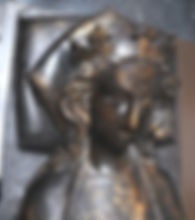The Westminster funeral and tomb
17 December saw the burial of Eleanor’s body at Westminster Abbey. The chroniclers agree that this was a splendid occasion. The Barnwell annalist thought the like had not been seen in England since the coming of the Christian faith; another that it was the most splendid ever seen or heard of. It is recorded that Eleanor was interred “with royal vestments, crown and sceptre, dust on forehead and breast in the form of a cross, and a wax candle with certain writings” (probably an indulgence, though bearing in mind Eleanor’s tastes I like to think of her going to her grave with a good book!). The location of her burial was the tomb previously vacated by Henry III, who had been upgraded to the Confessor’s old tomb.
The funeral was conducted by Oliver Sutton, the Bishop of Lincoln, since Archbishop Pecham was ill – and at odds with the Abbey over his privileges there.
With the chroniclers rendered dumbstruck by the magnificence of the event, we have few actual details, except that there were 49 candles – one for each year of Eleanor’s life – to accompany the coffin. But some sense of the likely glory of the service can be ascertained by looking at the next year’s memorial service.
For this, one hundred candles each weighing twelve pounds were to be lit. The weight of the candles was calculated to allow them to burn without interruption from that time until after high mass the next day. Bells were to be rung incessantly throughout this period and divine office chanted hourly with Placebo, Dirige and nine lessons. At the end of the commemoration alms were to be given to the poor, the mendicant friars and the London hospitals. Likewise a later memorial service records the Abbey ablaze with candles, with a structure bearing candles erected above the tomb.
The tomb itself is a masterpiece, and replete with details for which there is simply no space here (it is covered at greater length in the book)
The famous effigy tops the tomb. It was made by William Torel in 1291 from cast gilt bronze – a cutting edge approach probably borrowed from France where their most distinguished kings were given this accolade.

The image on the tomb shows Eleanor as she probably appeared on the funeral procession - dressed in flowing robes with one hand pulling gently at the cord of her mantle – as seen on her seal and repeatedly on the Cross images.

Her hair is unbound, as for a coronation, and she wears a full circlet crown, which would have been gilded and borne paste jewels – the holes can still be seen. Critically the tomb slab and the pillow beneath her head are carved again and again with the arms of Castile and Leon, invoking her heritage and status – and echoing Castilian textile styles.
The sides of the tomb continue the themes. Here we find six sets of shields, stating Eleanor’s full pedigree via the arms of Castile and Leon, Ponthieu, and England. Eleanor’s heritage is also referenced by the Norman-French inscription around the tomb "Here lies Eleanor, sometime Queen of England, wife of King Edward son of King Henry, and daughter of the King of Spain and Countess of Ponthieu, on whose soul God in His pity have mercy. Amen".
On the ambulatory side of the tomb is a fine carved iron grille by Thomas of Leighton Buzzard which evokes a garden trellis with plants growing up it – very apposite for Eleanor the gardener. Also on the ambulatory side is a painting (now effectively lost) which is thought to depict Otho de Grandison arrayed in chain armour praying for Eleanor in the Holy Land before the Virgin and Child. The floor of the ambulatory by the tomb was reportedly set with tiles depicting the queen between her favoured saints, St Edmund and St Thomas Becket.
Even when no special commemoration was taking place, Edward stipulated that Eleanor’s tomb was to be surrounded by thirty large candles at all times. All were to be lit on great feasts, and two were to be kept burning at all times. Until the Dissolution of the Monasteries under Eleanor’s descendant Henry VIII, this order was complied with. In around 1500 a visitor to the Abbey was told that candles had never ceased to burn on Eleanor’s tomb since her burial there.























